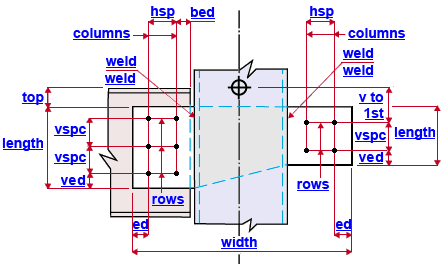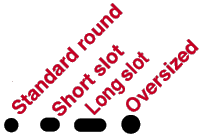"  Shear Thru Plate On [mem num] [end] " connection design locks
Shear Thru Plate On [mem num] [end] " connection design locks
| A shear thru plate can be designed through an HSS round (or pipe) or HSS rectangular (or tube) column. To create the following example, " Thru shear plate " needed to be set to ' Thru plate ' for each of the two opposing beams on opposite sides of the HSS column. |
|
|||||
"  |
|
||||
User Defined Connections: Settings that are locked (
) in a user defined connection file will automatically be locked on a member edit window for which that file is the " Input connection type ." You can, if you so choose, manually lock additional settings on the member edit window, and your changes will be retained, through multiple processes, so long as you do not change to a different connection then switch back to the original user defined connection.
Beam Edit: To change a setting, first set it to locked (
). Related settings that are unlocked (
) may be updated, and the "
Left/Right end limit state " calculations will be updated. Settings that are locked (
) will not be changed by connection design , even if doing so might prevent a connection failure.
| Locks not dimensioned or called out on the drawing are marked ( not depicted ). |
![]() Shear Thru Plate On [mem num] [end]
Shear Thru Plate On [mem num] [end]
Shear plate
Top of plate ( top ): The positive (+) or negative (-) distance from the top flange of the beam that you are editing to the top of the shear thru plate (see example ). The top flanges of both beams should be at the same elevation for a shear thru plate to work. A positive (+) distance places the top edge of the shear plate that distance below the top flange of the beam. A negative (-) distance places the top edge of the shear plate that distance above the top flange of the beam. Changing " Top of plate " moves the plate only and does not the change the location of the holes. Changing the " Vertical to 1st hole " moves the holes.
Plate length ( length ): The distance between the top and bottom edges of the thru plate in the half of the shear thru plate that bolts to the beam you are editing. in the example shown above, the " Plate length " for the left beam is greater than the " Plate length " for the right beam. If " Plate length " is unlocked (
), changing the number of " Rows " or " Vertical hole spacing " also changes the " Plate length ."
Plate width ( width ): The distance between the two vertical edges of the thru plate (see example ). If " Plate width " is unlocked (
), changing the number " Columns " or the " Horizontal hole spacing " or " Horizontal to 1st hole also adjusts the " Plate width ."
Plate thickness ( not depicted ): The " Material thickness " of the shear plate.
End connection failure message: Thru plates cannot be locked to different thickness
Bolts
Bolt diameter ( not depicted ): You can either type in any diameter (inches or mm), or you can select a bolt diameter from the combo box (
). The diameters that are listed in the combo box come from Home > Project Settings > Job > Bolt Settings > the " Available bolts " list. The bolt diameter entered here, together with the " Hole type " selected below, set the diameter of holes the bolts go into.
Hole type ( not depicted ): Standard round or Short slot or Oversized or Long slot or User slot #1 or User slot #2 . The hole type selected here together with the " Bolt diameter " entered above set the diameter of holes in the thru shear plate.

Rows: The number of rows of holes in the half of the shear thru plate that bolts to the beam you are editing. In the example above, this number is ' 3 ' for the left beam and ' 2 ' for the right beam. If " Plate length " is unlocked (
), changing the number of " Rows " also adjusts the " Plate length on the half of the thru plate that is associated with the beam you are editing.
Vertical to 1st hole ( v to 1st ): The distance (perpendicular to the work line of the supported beam from the top flange of the beam that you are editing to the center of the nearest row of holes on the shear thru plate. In the example shown, the " Vertical to 1st hole " distance is the same for both beams, but you can, if you choose to, make this distance different. Changing the " Vertical to 1st hole " moves the holes on the half of the shear thru plate that you are editing, but not the " Top of plate ."
Vertical hole spacing ( vspc ): The distance (center to center) between any two adjacent rows of holes on the half of the shear thru plate that bolts to the beam that you are editing. (see example ). If " Plate length " is unlocked (
), changing the " Vertical hole spacing " also adjusts the " Plate length " on the half of the thru plate that is associated with the beam you are editing.
Vertical edge distance ( ved ): The distance from the bottom edge of the shear thru plate to the nearest row of holes. This applies only to the half of the thru shear plate that is associated with the beam that you are editing. See the example .
Columns: The number of columns of holes on the half of the shear thru plate that bolts to the beam that you are editing. In the example above, this number is ' 2 ' for both the left beam and the right beam. You can, if you choose to, make this number different for the two beams. If " Plate width " is unlocked (
), changing the number " Columns " also changes the " Plate width ."
Beam edge distance ( bed ): The distance from end of the beam to the center of the nearest column of holes for bolting to the beam to the shear plate (see example ). If " Plate width " is unlocked (
), changing the " Beam edge distance " also changes the " Plate width ."
Horizontal hole spacing ( hsp ): The distance (center to center) between any two adjacent columns of holes on the side of the shear thru plate that bolts to the beam you are editing (see example ). If " Plate width " is unlocked (
), changing the " Horizontal hole spacing " also adjusts the " Plate width ."
Horizontal edge distance ( ed ): The distance from the vertical edge of the half of the thru shear plate that bolts to the beam you are editing to the center of the nearest column of holes for bolting to that same beam. If " Plate width " is unlocked (
), changing the " Horizontal edge distance " also adjusts the " Plate width ."
NS primary weld type: None or Double fillet or Single bevel groove or Groove w/ backing bar . This is the primary weld type for the near side of the half of the thru plate that bolts to the beam whose locks you are editing.
symbol name weld used for... 
fillet General welding of material. 
bevel groove General full penetration welding of material. NS primary weld size ( weld ): The primary weld size used to shop weld the near side of the shear thru plate to the supporting HSS, pipe or tube column. This is the primary weld size for the half of the thru plate that bolts to the beam whose locks you are editing. See the example .
FS primary weld type: None or Double fillet or Single bevel groove or Groove w/ backing bar . This is the primary weld type for the far side of the half of the thru plate that bolts to the beam whose locks you are editing.
NS primary weld size ( weld ): The primary weld size used to shop weld the far side of the shear thru plate to the supporting HSS, pipe or tube column. This is the primary weld size for the half of the thru plate that bolts to the beam whose locks you are editing. See the example .
Secondary weld type: None or Double fillet or Single bevel groove or Groove w/ backing bar . This is the secondary weld type for the half of the thru plate that bolts to the beam whose locks you are editing.
symbol name weld used for... 
fillet General welding of material. 
bevel groove General full penetration welding of material. Secondary weld size: The secondary weld size used to shop weld the shear plate to the supporting HSS, pipe or tube column. This is the secondary weld size for the half of the thru plate that bolts to the beam that you are editing.







